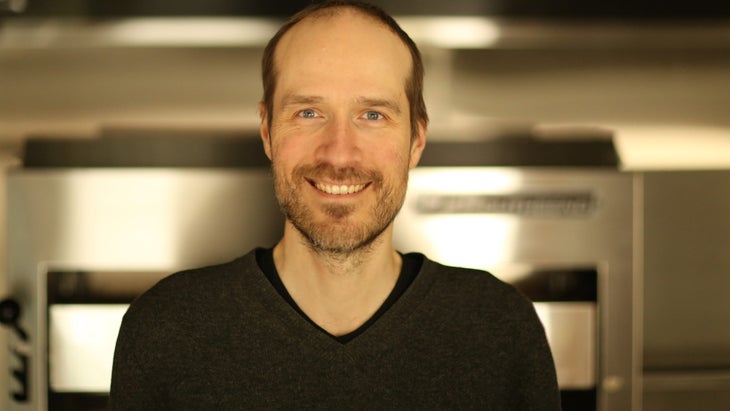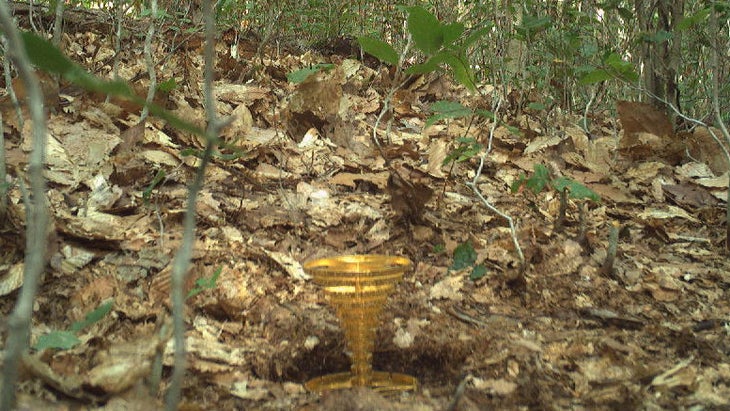Early on in his career, video game designer Jason Rohrer embarked on a strange quest. Instead of trying to make huge blockbusters like Halo or Grand Theft Auto, he produced games about what it means to be human. His work was an argument that video games could be about more than shooting robots and aliens. He wanted to make people laugh, love, and cry.
His game Passage is a five-minute meditation on the beauty of life and the inevitability of death and part of the permanent collection at the Museum of Modern Art. A Game for Someone was designed to only be played 2,000 years in the future and is currently buried somewhere in the Nevada desert.
“He created a nesting doll game that could not be completed in a single human lifetime called Inside a Star Filled Sky,” Patrick Jagoda, a game designer and English professor at the University of Chicago told me. “His games have been very, very high concept.”
But now, Rohrer is taking his art from the digital space and into the real world with a treasure hunt based in New England. On Thursday, Rohrer launched the hunt, called Project Skydrop. The first person to solve his seemingly straightforward puzzle will find a gold statue and bounty of cryptocurrency. But given the ambition and scope of his previous work, most everyone familiar with his games—including me—is wondering: What does Rohrer have up his sleeve this time?
The Details of the Hunt
Project Skydrop is like a treasure hunt from the future. Instead of a brittle, yellowed map or a cryptic poem guiding searchers, this hunt is largely digital. The treasure itself is a sculpture made of 10 oz of solid gold—worth about $23,000—engraved with a Bitcoin wallet recovery phrase that unlocks a further crypto bounty: 50 percent of the pool of $20 entry fees to join the hunt. The sculpture isn’t buried, or even hidden. It’s just sitting out somewhere in the open in New England.
The clues? A combination of aerial photographs that start unhelpfully close to the treasure—one foot off the ground—and a circle on a map that starts out unhelpfully far away—a 500-mile radius. Every day, the aerial photographs zoom out to provide more context about the treasure’s surroundings. Every day the circle shrinks—down to a one-foot diameter search area after three weeks.

“I know it’s not gonna be solvable on day one,” Rohrer told me from his home in New Hampshire. “And I know it’s definitely going to be solvable on day 21.”
“Definitely solvable” is an attribute that few other treasure hunts have had over the years. Most have failed in one way or another.
Forrest Fenn’s million-dollar chest of gold took ten years to find, and five searchers died in pursuit. By the end of it, in 2020, Fenn was the subject of several lawsuits. Because of this chaos, the treasure’s finder did his best to remain anonymous, and to this day the general public doesn’t know exactly where the treasure was hidden. It’s a mess.
Twelve treasures were buried in major American cities for The Secret, a treasure hunt created by Byron Preiss in 1982, but so far only three have been found. Preiss died in 2005. That hunt was simply too hard.
Even the original armchair treasure hunt, Masquerade, from 1979, ended in scandal when it turned out that the finder had used inside information to locate the jewel-encrusted golden hare that people were looking for.

The legacy of modern treasure hunts, in other words, is controversy, scandal, and failure. They end badly. They look a lot like video games that needed a little more playtesting before being released.
“Treasure hunts in the past haven’t really worked that well,” Rohrer said. “They kind of fundamentally break.”
Project Skydrop, then, is a game designer’s response to those failures. The shrinking-circle, closed-timeline design of the hunt keeps it from dragging on for decades. The final location of the treasure and the identity of the finder won’t be a mystery: in order to claim the Bitcoin, the finder is required to upload a video of themselves with the treasure when they find it.
Rohrer and his creative partner, Thomas Bailey, have also taken steps to make sure that no one gets hurt by another searcher.
“Let’s say the treasurer’s worth a million dollars, right? It’s life-changing money. And as you come over the crest, you see someone a few feet closer to the treasure than you. What do you do? Do you start running? Do you start screaming? Do you start shooting? So we had to figure out a way to prevent that as best we could.”
Averting Another Forrest Fenn Debacle
What they came up with is a clause in the entry agreement that searchers must “obtain the treasure peacefully,” and in the hope of enforcing that rule Rohrer and Bailey fitted the area around the treasure with cameras—like a bizarro, non-violent Hunger Games.
Those cameras upload to the Project Skydrop website in real time, so barring technical difficulties, anyone who pays the hunt’s entry fee can watch the treasure hunt unfold, including the moment someone finds and claims tens- or hundreds-of-thousands of dollars worth of treasure.
“If you think about that moment,” Rohrer said, “and what that moment will feel like in the grand scope of all human experience, it’ll just be an incredible moment, right?”
It will be quite the moment. But is it art? Is it very, very high concept?
“It is possible that he made a treasure hunt and that’s it, full stop,” Patrick Jagoda told me. “But based on the 20-or-so games that he’s made in the past, I bet you there are layers of meaning to what this thing is.”
Perhaps sending people out into the world in the pursuit of a solid gold sculpture is a statement on being a celebrated video game creator, but not a particularly well-compensated one. Perhaps it’s a commentary on our increasing dependence on screens and pictures and satellite imagery to navigate the natural world. Perhaps he just wants to make the real world feel a little bit more like a video game.

When I asked Rohrer directly if there was more going on here than meets the eye, he laughed because even if there was, he said he wouldn’t be telling me about it.
But then he told a long story about his most successful game, One Hour, One Life, in which players build a family and then a civilization over the course of generations and every hour of gameplay equals one human lifespan. One Hour, One Life incorporates a lot of the themes of his early games—the meaning of life and death, and��the way our actions today echo into the future.
As the creator of this game, however, he can see how people are playing it—the degree to which a digital life can take over a real one.
“When the game first came out and I was looking at statistics, there were a number of players who played it ten hours a day, seven days a week for like 11 months,” he said.
“I’ve interacted with a number of members of this community and, you know, a lot of them are like 25 years old, living at their parents house, spending all day playing video games. And some of the interactions I’ve had have been pretty heartbreaking. It’s like, ‘I know that I’ll never have a family of my own. And the only way I get to feel like the joy of parenthood is through your game. Thank you, Jason.’
“I feel like I want to make something that kind of lifts them up out of that and kind of energizes them or something—gets them out of their chair.”
When Forrest Fenn launched his treasure hunt, he did it to get kids “out of the game room, off their texting machines and into the mountains,” he said.
Fenn spent much of his life in the mountains. Rohrer has spent much of his life making video games. But they’ve arrived at a similar place.
“Like yesterday I climbed to the top of a mountain with my wife and two younger children and our dog,” he said. “And we picked wild blueberries up at the top of the mountain. And it was a really hot day and once we got down to the bottom of the mountain we swam in these beautiful cascading, crystal clear waterfalls. That felt like living to me.”
In other words, Rohrer is still exploring what it means to be human. He’s still trying to make people laugh, love, and cry. But as the creator and curator of all that screen time, it seems like he’s also now trying to atone for something.


